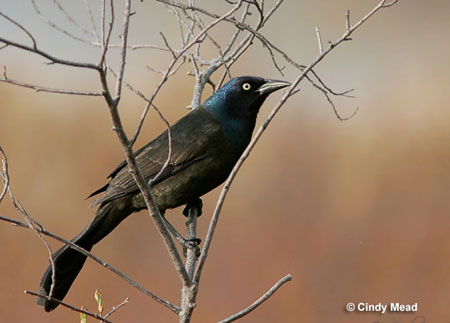The Common Grackle is a lean, large bird. It’s a blackbird that looks slightly stretched. They have long tails, long legs, flat heads, and bills that are larger than other blackbirds.
Their bills have a downward curve to them as well. When flying, Common Grackle wings look short to their tails.
Common Grackles prefer to inhabit marshes, open, wet woodland, suburbs, agricultural fields, and parks. A good way to find these birds is to scan for large flocks of starlings and blackbirds.
Grackles walk around fields and lawns on their long legs and congregate in noisy groups high up in trees.
On this page
Identification
Common Grackles look black from far away, but you’ll see their iridescent purple heads and glossy bronzy bodies when you look closer. In addition, they have golden eyes that give them an intense expression.
These birds are 11.0 to 13.4 inches (28 to 34 centimeters) long, weigh 2.6 to 5.0 ounces (74 to 142 grams), and have a wingspan of 14.2 to 18.1 inches (36 to 46 centimeters). Common Grackles are larger than a Red-winged Blackbird and around the same size as a Mourning Dove.
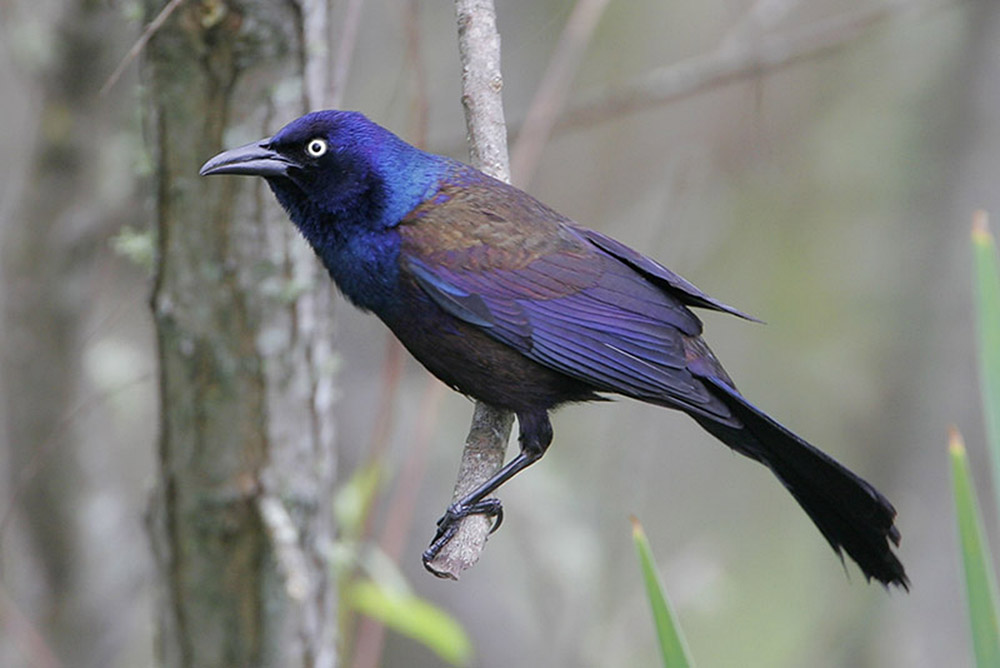
Photograph © Greg Lavaty.
Female Common Grackles are not as glossy as males and can be smaller. Otherwise, they look exactly the same.
They have iridescent purple heads, glossy bronzy bodies, and golden eyes that give them that same intense expression. They’re the same size and length and have the same wingspan as breeding males. They also weigh the same amount.
Common Grackles do have some regional differences. The “bronzed grackle” breeds in New England and west of the Appalachian Mountains. These birds have a bronzy back, hence where they got their name from. Common Grackles in the Southeast, from Louisiana to North Carolina, are called the “Florida grackle.”
Florida Grackles are purple on the belly and darker green on their backs rather than bronzy. A race that lives between the ranges of the Bronzed Grackle and the Florida Grackle is called the Purple Grackle, and they live on the Eastern seaboard.
Food
The Common Grackle has a diet that mainly consists of seeds. They especially love seeds from agricultural grains like rice and corn. It’s not uncommon to see these birds at backyard bird feeders in big flocks.
They prefer sunflower seeds and cracked corn. You should sprinkle these foods on the ground because Common Grackles will take over the feeders and scare away smaller birds.
In the wild, Common Grackles look for tree seeds such as sweetgum, acorns, garbage, and cultivated and wild fruits.
In the summer months, a decent portion of a Common Grackle’s diet consists of animals like beetles, caterpillars, grasshoppers, spiders, mollusks, crustaceans, fish, salamanders, other birds, frogs, and mice.
Nesting and Eggs
The female Common Grackle is the one to choose the nest site. Her partner will occasionally follow along as she searches for a spot.
It’s not uncommon for female Common Grackles to change their minds about the nesting area after they start building a nest. They’ll abandon the nest they’re currently building and choose another site to start building a new one.
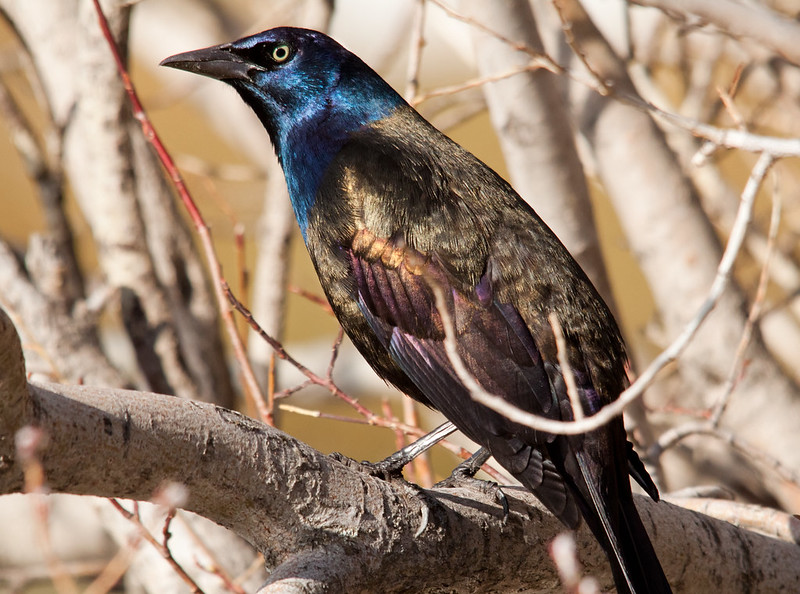
© Shawn McCready
Nests are usually built on a horizontal branch or between two vertical limbs in coniferous trees. However, nests have been built in cattails and deciduous vegetation as low as 8 inches off the ground.
Common Grackles often build their nests near water, and it’s not common for them to nest in woodpecker holes, birdhouses, cliff crevices, and barns.
Female Common Grackles are the ones to create the nest as well. Males will sometimes help or make repairs. The female can take anywhere from one week to six weeks to complete the nest.
It’s a large cup made of leaves, twigs, grasses, string, pieces of paper, corn husks, and cloth. The female Common Grackle will fortify the cup with mud and line it with horse hair and fine grasses.
At completion, the nest is 6 to 9 inches wide, 3 to 9 inches deep, and has an interior diameter of 3 to 5 inches.
- The clutch size is 1 to 7 eggs.
- Common Grackles have 1 to 2 broods per breeding season.
- Egg length can be anywhere from 1.0 to 1.3 inches (2.5 to 3.3 centimeters).
- Egg width can be anywhere from 0.8 to 0.9 inches (1.9 to 2.3 centimeters).
- The incubation period is 11 to 15 days.
- The nestling period is 10 to 17 days.
- Eggs can be pearl gray, light blue, dark brown, or white. They usually have brown spots as well.
Current Situation
Common Grackles are birds that thrive in human landscapes. They forage on the open ground and nest in scattered trees. These birds inhabit forest edges, open woodland, grassland, swamps, meadows, palmetto hammocks, and marshes.
It’s also common to see them in feedlots, agricultural fields, suburbs, cemeteries, city parks, hedgerows, and pine plantations. The only place you will most likely not see Common Grackles are uninterrupted forests.
Common Grackles are widespread and very common. However, their population has declined by almost 2% annually since the late 1960s.
This means the total decline of this species is 54%. Their breeding population is estimated to be around 67 million. Lastly, Common Grackles are said to be steeply declined by Partners in Flight.
Facts
- Common Grackles are extremely opportunistic birds. They’ll consume almost any food they can find. That’s why they’re often seen in parking lots and around picnic tables.
- Common Grackles practice “anting.” Anting involves a bird being hunched over on the ground, with its wings spread, letting ants crawl all over its feathers and body. Many bird species do this. Ants secrete formic acid from their stings and can help the bird rid itself of parasites.
- In the winter months, Common Grackles will roost and forage in large flocks with many different blackbird species. These flocks can have millions of individuals.
- Common Grackles are known to mimic other birds. They’re not as good as the Mockingbird, but they still do an impressive job! Common Grackles have a sharp and distinct song that varies by season. These birds can even mimic human noises!
Similar Species
The Common Grackle has features that are similar to other bird species. Here are some similar species:
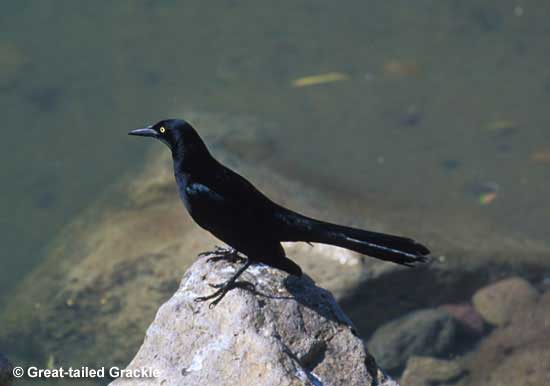
Great-tailed Grackle
Common Grackles are smaller than Great-tailed Grackles and have shorter, straight tails.
Female Common Grackles are darker overall compared to female Great-tailed Grackles.
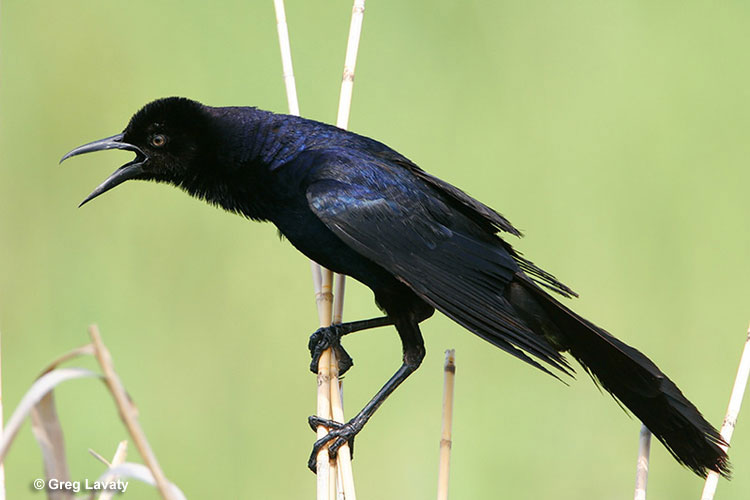
Boat-tailed Grackle
Common Grackles are smaller than Boat-tailed Grackles and have shorter, straight tails.
Female Common Grackles are darker overall compared to female Boat-tailed Grackles.
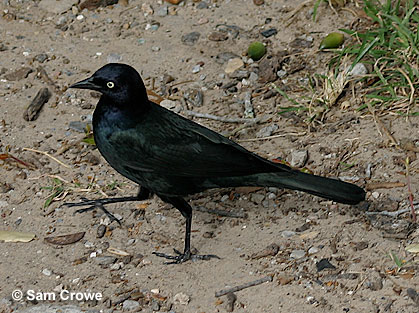
Brewer’s Blackbird
Common Grackles are larger than Brewer’s Blackbirds and have longer tails.
Adult male Brewer’s Blackbirds have purplish heads, while Common Grackles have bluish heads.
Female Brewer’s Blackbirds have more muted head feathers and dark eyes.
However, it’s important to note that some female Brewer’s Blackbirds have light eyes.
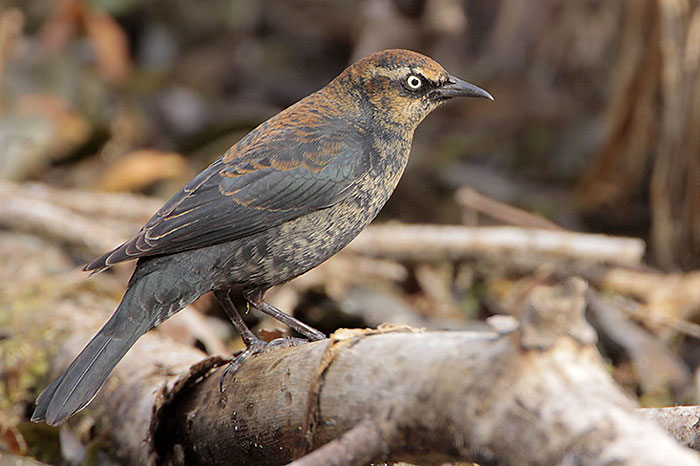
Rusty Blackbird. Photograph © Greg Lavaty
Common Grackles are bigger, have larger bills, and have longer tails than Rusty Blackbirds.
Nonbreeding male Common Grackles don’t have the rusty coloring that nonbreeding male Rusty Blackbirds do.
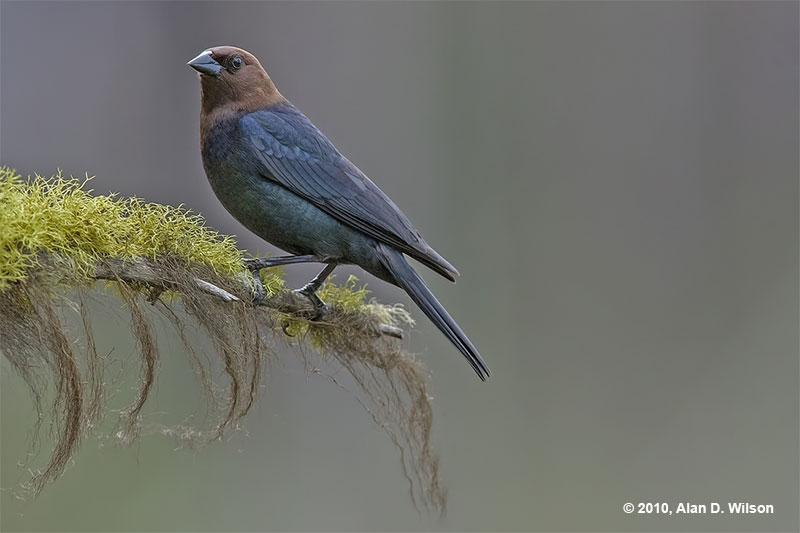
Brown-headed Cowbird
Common Grackles are bigger and have longer tails than Brown-headed Cowbirds.
Common Grackles have bluish heads, while Brown-headed Cowbirds have dark brown heads.
Frequently Asked Questions
Are grackles good to have around?
It’s good to have Common Grackles around! They eat bugs and rodents and have amusing behaviors!
Why do people not like grackles?
Common Grackles are known to be bullies at bird feeders. Not only do they make it difficult for other birds to come and eat, but they’ll also scare other birds away. Additionally, Grackles travel in large groups with other blackbirds. As a result, they can wipe out seed very quickly.
Are Common Grackles invasive?
No, Common Grackles are not invasive. It’s native to North America.
Do Common Grackles eat other birds?
Yes, Common Grackles do eat other birds. They’re more known for eating nestlings and other birds’ eggs, but they will sometimes kill and eat other adult birds.

